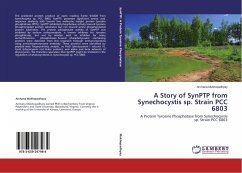The predicted protein product of open reading frame slr0328 from Synechocystis sp. PCC 6803, SynPTP, possesses significant amino acid sequence similarity with known low molecular weight protein tyrosine phosphatases (PTPs). SynPTP exhibited phosphatase activity toward tyrosine phosphorylated protein substrates but not toward serine phosphorylated protein substrates. The protein phosphatase activity of SynPTP was inhibited by sodium orthovanadate, a known inhibitor for tyrosine phosphatases, but not by okadaic acid, an inhibitor for many serine/threonine phosphatases. Several phosphotyrosine containing proteins were detected from this organism through immunoreactions using anti-phosphotyrosine antibody. These proteins were identified by peptide-mass fingerprinting analysis, as PsaD (photosystem I subunit II), CpcD (phycocyanin rod linker protein), and alpha and beta subunits of phycocyanin. We therefore speculate that SynPTP might be involved in the regulation of photosynthesis inSynechocystis sp. PCC 6803.
Bitte wählen Sie Ihr Anliegen aus.
Rechnungen
Retourenschein anfordern
Bestellstatus
Storno








